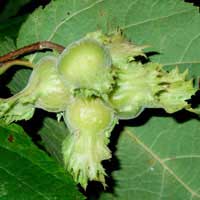 Full List of Fruits
Full List of Fruits  American Hazelnut
American HazelnutAmerican Hazelnut
![]() Introduction of American Hazelnut
Introduction of American Hazelnut
Scientific name - Corylus americana
Native to eastern North America, the American Hazelnut nurtures as a strong multi-stemmed shrub which is best grown at full sun. During the fall, the color of the leaves change to red or purple from golden yellow! The nuts have higher nutritional value. It is a member of the Betulaceae family, which includes alders, birches, and hornbeams. The plant is also known as American filbert, American hazel, and smoothbark hazel. It is a deciduous shrub that grows from 6 to 12 feet tall, with a rounded, spreading crown.
The bark is smooth and gray, and the twigs are slender and brown. The leaves of American hazelnut are ovate to obovate, with a toothed margin and hairy underside. The flowers are small, greenish-yellow, and unisexual. The male flowers form in drooping catkins, while the female flowers are found in clusters of two to three. The fruits are edible nuts enclosed in a husk. They ripen in the fall and can be eaten raw or roasted. American hazelnut is an important wildlife food, providing food for birds and small mammals. It is also a popular ornamental shrub, with attractive yellow, red, and orange fall foliage. The nuts are edible and can be eaten raw or roasted, or ground
![]() Description of American Hazelnut
Description of American Hazelnut
Native to Eastern North America, Corylus Americana i.e. the American Hazelnut, is a species of the genus Corylus. It grows upto 3-8 feet and it is at its best in dry or moist thickets, woodland, and borders of woodland, in valleys and upland. The flowering takes place during March-may and it is during July-September the fruit ripens. The fruit is globe shaped in a large, leaf-like covering. The nuts are nutritious and sweet and can be eaten raw or ground into flour for cake-like bread. The nut grows as a strong multi-stemmed shrub and for best growth and development, it prefers full sun. The nuts mature during September-October.
Rich in folate, these nuts are an excellent source of Vitamin E and are packed with B-complex groups of vitamins such as riboflavin, niacin, thiamin, pantothenic acid, pyridoxine (vitamin B-6), and folates. These hazelnuts are widely used in confectionaries chocolates, cakes and in several other items. They are also used in making butter. It is highly recommended that you buy unshelled raw nuts as a replacement for of processed ones. Avoid nuts with molds, cracks and spots, prefer bright brown-yellow color, compact, uniform in size and feel heavy in hand.
![]() Nutritional Value of American Hazelnut
Nutritional Value of American Hazelnut
| Principle | Nutrient Value | Percentage of RDA |
|---|---|---|
| Energy | 628 Kcal | 31% |
| Carbohydrates | 16.7 g | 13% |
| Protein | 14.95g | 26.5% |
| Total Fat | 60.75 g | 202% |
| Cholesterol | 0 mg | 0% |
| Dietary Fiber | 9.7 g | 25.5% |
| Vitamins | ||
| Folates | 113 µg | 28% |
| Niacin | 1.8 mg | 11% |
| Pantothenic acid | 0.918 mg | 18% |
| Pyridoxine | 0.563 mg | 43% |
| Riboflavin | 0.113 mg | 9% |
| Thiamin | 0.643 mg | 53.5% |
| Vitamin A | 20 IU | <1% |
| Vitamin C | 6.3 mg | 10.5% |
| Vitamin E | 15 mg | 100% |
| Vitamin K | 14.2 µg | 12% |
| Electrolytes | ||
| Sodium | 0 mg | 0% |
| Potassium | 680 mg | 14% |
| Minerals | ||
| Calcium | 114 mg | 11% |
| Copper | 1.725 mg | 192% |
| Iron | 4.7 mg | 59% |
| Magnesium | 163 mg | 41% |
| Manganese | 6.17 mg | 268% |
| Phosphorous | 290 mg | 41% |
| Zinc | 2.45 mg | 22% |
![]() Health Benefits of American Hazelnut
Health Benefits of American Hazelnut
Prevent coronary artery disease.
Protect from cancer.
Cure celiac disease patients.
Rich in Antioxidants.
May Help Manage Blood Sugar Levels.
![]() Methods of Propagation in American Hazelnut
Methods of Propagation in American Hazelnut
- Seed Propagation: American hazelnuts can be propagated from seed with good success. Seeds can be planted directly in the ground in late fall or early spring. Seeds should be planted about 1 inch deep in well-drained soil.
- Cuttings: American hazelnuts can be propagated from cuttings. Take 6-8 inch hardwood cuttings in winter, when the plant is dormant. Dip the cut ends in rooting hormone and plant in a pot filled with well-drained soil.
- Layering: American hazelnuts can be propagated by layering. Choose a branch near the ground and bend it onto the soil. Secure the branch in place and cover with soil. The branch should root within a few months.
- Division: American hazelnuts can be propagated by division. Dig up the plant and carefully separate the root ball into several sections. Replant each section in a separate pot or in the ground.
- Grafting: American hazelnuts can be grafted onto rootstock. Cut a scion from a donor plant and carefully graft it onto a rootstock. Make sure the graft takes before planting in the ground or pot.


















